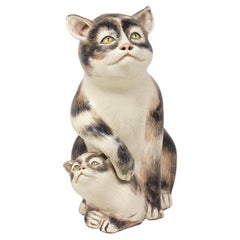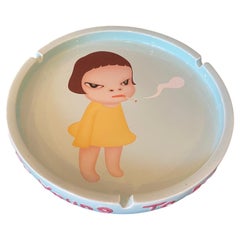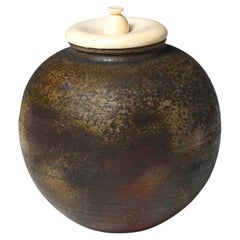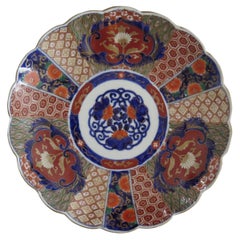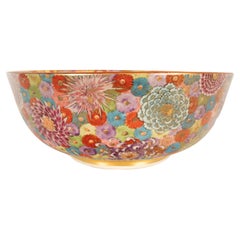Japanese Ceramics
to
356
495
388
918
523
32
33
10
4
4
4
4
3
1
59
456
403
555
161
92
39
33
4
7
11
4
7
3
6
5
2
1,406
923
389
237
93
4,163
3,534
1,946
1,473
513
1,473
1,458
1,458
28
17
16
12
9
Place of Origin: Japanese
Antique Japanese Meiji Period Pottery Cat and Kitten Okimono
Located in Newark, England
EARLY MEIJI PERIOD (1868-1912)
From our Japanese Pottery collection, we are delighted to offer this charming Japanese Pottery Cats Okimono. The Pottery Cats Okimono consisting of a...
Category
Late 19th Century Meiji Antique Japanese Ceramics
Materials
Ceramic, Earthenware, Pottery
Antique Japanese Meiji Period Satsuma Vase by Okamoto Ryozan for Yasuda Company
Located in Newark, England
MUSEUM QUALITY SATSUMA VASE BY OKAMOTO RYOZAN
From our Japanese Satsuma collection, we are absolutely delighted to bring to market this exceptional Japanese Satsuma Vase by Okamoto...
Category
Early 1900s Meiji Antique Japanese Ceramics
Materials
Ceramic
Yoshitomo Nara, Too Young to Die, Japanese Glazed Porcelain Ceramic Ashtray 2002
By Yoshitomo Nara 1
Located in Studio City, CA
A beautiful and highly coveted large finely glazed ceramic ash tray/ low bowl by famed Japanese Pop artist Yoshitomo Nara (奈良 美智, 1959- ) titled "Too Young To Die". The wonderful im...
Category
Early 2000s Modern Japanese Ceramics
Materials
Ceramic, Porcelain
Japanese Bizen ware bunrin chaire by Toho Kimura
Located in Point Richmond, CA
Japanese Bizen ware bunrin chaire by Toho Kimura.
A ceramic powdered tea container for the Japanese tea ceremony. The globular body delicately potted and mottled with ash adhesions,...
Category
Early 20th Century Taisho Japanese Ceramics
Materials
Ceramic
Japanese Porcelain Charger or Large Plate Hand Painted Imari, 19th C Meiji
Located in Lincoln, Lincolnshire
This is a good quality Japanese porcelain large plate or dish or charger with an Imari pattern, dating to the mid-late 19th century, Meiji period, circa 1870.
The plate or charger...
Category
19th Century Meiji Antique Japanese Ceramics
Materials
Porcelain
Antique Meiji Japanese Satsuma Porcelain Hand Painted Millefleur Bowl by Hakusan
Located in Portland, OR
An outstanding, fine, antique Japanese Meiji Period (1868-1912) Satsuma Millefleur pottery bowl, by Hakusan, circa 1890.
This outstanding Satsuma bowl is very finely handpainted & gi...
Category
1890s Meiji Antique Japanese Ceramics
Materials
Porcelain
Antike Awaji Pottery braided with bamboo, Japan around 1900s
Located in Hannover, DE
This beautiful vase is hand made and its made in japan. all the materials used to make this vase are natural. one can use this vase to decorate the room in different ways. One can ch...
Category
Early 1900s Antique Japanese Ceramics
Materials
Ceramic
Japanese Porcelain Green Umbrella Stand 1970s
Located in Paris, FR
This is an umbrella stands which was made in Japan around 1970 in showa era.
It is made with porcelain. The colour of this umbrella stand is light green and it has some leaves motif....
Category
Late 20th Century Showa Japanese Ceramics
Materials
Porcelain
Japanese Porcelain Charger finely Hand Painted, Meiji Period circa 1880
Located in Lincoln, Lincolnshire
This is a good quality, hand decorated Japanese porcelain charger, large plate or bowl with an Imari pattern, dating to the late 19th centur...
Category
Late 19th Century Meiji Antique Japanese Ceramics
Materials
Porcelain
Geode and kintsugi Bizen vase
Located in MEAUX, FR
Restored Bizen stoneware vase with kintsugi and geode
This 13 cm high Bizen stoneware vase is a unique and exceptional piece. Doubly incredible, it was broken and then restored ...
Category
21st Century and Contemporary Japanese Ceramics
Materials
Gold
Japanese Earthenware Meiji Period Satsuma Iris Vase by Ryuzan
Located in Newark, England
Meiji Period (1868-1912)
From our Japanese collection, we are delighted to offer this Japanese Satsuma Iris Vase Painted by Ryuzan. The Japanese Satsuma vase of tall tapered form features a circular rolled foot rim, slightly pinched base with a tapered body and slightly bulbous opening. The vase is decorated with a central continuous band of bright iris flowers with various shades of green to the stems and beautiful violet petals. The central band is framed by greek key borders and honeycomb geometric patterns to the top and bottom. The vase is signed to the base Ryuzan 龍山 and dates to the Meiji Period (1868-1912) and the late 19th century circa 1895.
Satsuma ware is a type of earthenware pottery originating from the Satsuma province in Southern Kyushu, Japan’s third largest island.
Meiji Period was an era of Japanese history that spanned from 1868 to 1912. It was the first half of the Empire of Japan, when the Japanese people began to build a paradigm of a modern, industrialised nation state and emergent great power, influenced by Western countries and aesthetics. As a result of radically different ideas, the changes to Japan were profound and it affected the social structure, politics, economy, military, and foreign relations across the board. The period corresponded to the reign of Emperor Meiji and was preceded by the Keio era and was succeeded by the Taisho era.
Cultural Art during the Meiji Period was of particular interest to the government and they overhauled the art export market which in turn promoted Japanese arts via various world’s fairs, beginning in Vienna at the world fair in 1873. The government heavily funded the fairs and took an active role organising how Japan’s culture was presented to the world including creating a semi-public company named Kiritsu Kosho Kaisha (First Industrial Manufacturing Company). The Kiritsu Kosho Kaisha was used to promote and commercialise exports of Japanese art and established the Hakurankai Jimukyoku (Exhibition Bureau) to maintain quality standards. For the 1876 Centennial International Exhibition in Philadelphia, the Japanese government created a Centennial Office and sent a special envoy to secure space for the 30,000 items that would be displayed. The Imperial Household also took an active interest in arts and crafts, commissioning works by select artists to be given as gifts for foreign dignitaries further emphasising the high quality and importance of Japanese art. Just before the end of the 19th century in 1890, the Teishitsu Gigeiin (Artist to the Imperial Household) system was created to recognise distinguished artists. These artists were selected for their exceptionally high quality wares and talent in their own industry. Over a period of 54 years Seventy artists were appointed, amongst these were ceramicist Makuzu Kozan and cloisonné enamel artist...
Category
Late 19th Century Meiji Antique Japanese Ceramics
Materials
Earthenware
Japanese Meiji Period (1868-1912) Satsuma Earthenware Vase Taizan for Hattori
Located in Newark, England
Meiji Period (1868-1912)
From our Japanese collection, we are delighted to offer Japanese Meiji Period Satsuma Vases. The Satsuma Vase of hexagonal form with a slight waisted neck and tight rounded rim is extensively decorated with multiple figures to two large scenes. The first scene features a beach with waves to the background and a plethora of figures including multiple geisha holding traditional Japanese wagasa’s. The second scene follows on from the first with a large building in the foreground holding figures on a large platform under a pagoda roof with a pagoda building in the background and further figures in the foreground. The scenes are framed by a full detailed border with gilt shapes, flowers amongst pink shaded backgrounds and butterflies around the neck. The Satsuma Vase is unusually signed Fine Art, Satsuma Ware, Dai Nippon (Great Japan), Hattori Made, Gosuido Works, Taizan Painted. 美術, サツマヤキ(薩摩焼), 大日本, 服部造, 五スイ堂工, 對山画 and dates to the Meiji Period (1868-1912) and the turn of the 20th century circa 1905.
Satsuma ware is a type of earthenware pottery originating from the Satsuma province in Southern Kyushu, Japan’s third largest island.
Wagasa are traditional Japanese umbrellas made of washi paper attached to a bamboo frame and treated to ensure it is waterproof.
Meiji Period was an era of Japanese history that spanned from 1868 to 1912. It was the first half of the Empire of Japan, when the Japanese people began to build a paradigm of a modern, industrialised nation state and emergent great power, influenced by Western countries and aesthetics. As a result of radically different ideas, the changes to Japan were profound and it affected the social structure, politics, economy, military, and foreign relations across the board. The period corresponded to the reign of Emperor Meiji and was preceded by the Keio era and was succeeded by the Taisho era.
Cultural Art during the Meiji Period was of particular interest to the government and they overhauled the art export market which in turn promoted Japanese arts via various world’s fairs, beginning in Vienna at the world fair in 1873. The government heavily funded the fairs and took an active role organising how Japan’s culture was presented to the world including creating a semi-public company named Kiritsu Kosho Kaisha (First Industrial Manufacturing Company). The Kiritsu Kosho Kaisha was used to promote and commercialise exports of Japanese art and established the Hakurankai Jimukyoku (Exhibition Bureau) to maintain quality standards. For the 1876 Centennial International Exhibition in Philadelphia, the Japanese government created a Centennial Office and sent a special envoy to secure space for the 30,000 items that would be displayed. The Imperial Household also took an active interest in arts and crafts, commissioning works by select artists to be given as gifts for foreign dignitaries further emphasising the high quality and importance of Japanese art. Just before the end of the 19th century in 1890, the Teishitsu Gigeiin (Artist to the Imperial Household) system was created to recognise distinguished artists. These artists were selected for their exceptionally high quality wares and talent in their own industry. Over a period of 54 years Seventy artists were appointed, amongst these were ceramicist Makuzu Kozan and cloisonné enamel artist...
Category
Early 1900s Meiji Antique Japanese Ceramics
Materials
Earthenware, Pottery
Japanese Little Porcelain Box for Incense and Jewelry 1980s KOUUN
Located in Paris, FR
This is a small box which is made with porcelain.
This can be used as KOURO (the box we use to put some incense which we use during a traditional tea ceremony.). And also as a jewelr...
Category
Late 20th Century Showa Japanese Ceramics
Materials
Porcelain
Japanese Antique Satsuma Pottery Buddhist Monks Vase with Shimazu Crest Mark
By Satsuma
Located in Studio City, CA
A beautiful Japanese Satsuma pottery studio vase featuring multiple kesa-clad enlightened Buddhist monks on each side of the vase. The piece is finely detailed with rich raised gilt highlights throughout and beautifully decorated in gold and various hand painted other colors.
From the Meiji period (1868-1912).
This piece has the all-important Shimazu Family crest mark (red circle with a cross inside) on the base authenticating the work as an old and original Satsumaware work. The mark shows the pottery was made under the rule of the Shimazu clan.
From a Los Angeles Collection...
Category
Early 20th Century Meiji Japanese Ceramics
Materials
Earthenware, Pottery
Pair of Japanese Satsuma 'Moriage' Porcelain Gilt Vases
By Satsuma
Located in LA CIOTAT, FR
This handsome pair of 20th century glazed and gilded Japanese Satsuma vases, with their vivid, jewel-like colours and elegant baluster-shaped forms, feature the traditional Japanese ...
Category
20th Century Japanese Ceramics
Materials
Porcelain
Antique Japanese Imari Porcelain Umbrella Stand
By Imari Porcelain
Located in LA CIOTAT, FR
An ideal decoration for a stylish hallway, this Japanese Imari porcelain umbrella stand dates from the end of the 19th century. Known for its colourful decorative style, Imari porcelain features vivid hand-painted designs in bright shades of cobalt blue, red, gold and black and this unfussy but elegant cylindrical vase is a prime example. Also typical of the style is its busy motif of wise elders deep in conversation in a landscape, surrounded by radiant cherry blossoms and peonies, bamboo stems and pendulous willow boughs...
Category
19th Century Antique Japanese Ceramics
Materials
Porcelain
Large 19th Century Japanese Imari Ware Porcelain Vase
Located in Bradenton, FL
A large scale and very good quality late 19th century Japanese Imari vase with exotic birds, trees and flowers. Wonderful coloring in vibrant hues of blue, red and rust.
Category
19th Century Japonisme Antique Japanese Ceramics
Materials
Porcelain
Rosanjin Kitaoji Signed Japanese Bizen Pottery Vase & Original Signed Sealed Box
By Rosanjin Kitaoji
Located in Studio City, CA
An absolutely gorgeous hand-crafted Bizen Yaki Ware pottery vase by Japanese master potter Kitaoji Rosanjin (1883-1959) who was arguably one of if not the greatest artists/ceramicist...
Category
Mid-20th Century Showa Japanese Ceramics
Materials
Pottery, Stoneware
Japanese Porcelain Floral Vase
Located in Greenwich, CT
Japanese porcelain floral vase
4.5" diameter 5" height
Category
1940s Vintage Japanese Ceramics
Materials
Porcelain
Kaneshige Toyo National Treasure Signed Japanese Bizen Pottery Sake Bottle Vase
Located in Studio City, CA
A beautiful, perfectly shaped and balanced antique Bizen ware shibui sake bottle (tokkuri) vase by renowned Japanese master potter/artist Kaneshige Toyo (1896-1967) featuring a unique natural, wonderfully textured organic forming ash glaze. Kaneshige is universally considered to be the founder of modern Bizen pottery.
In 1956, Kaneshige was certified as a Living National Treasure (Important Intangible Cultural Heritage) for his work in Bizen Ware pottery/ceramics. Bizen Ware is a type of Japanese pottery traditionally from the Bizen province, presently a part of the Okayama prefecture. It is considered one of the Six Ancient Japanese Kilns (along with Echizen ware, Seto ware, Shigaraki ware, Tamba ware, and Tokoname ware).
The piece is signed/ sealed on the base with one of Kaneshige's traditional incised marks.
A rather striking and engaging work. One of the best Kaneshige works we have come across. Scarce and hard to find in such an excellent condition. Would be a fantastic addition to any Japanese/Asian pottery or Bizen Ware collection or eye-catching stand-alone work in about any setting.
Kaneshige's work can be found in numerous prominent collections and museums including:
Aichi Prefectural Ceramic Museum, Seto, Japan
Brooklyn Museum, NY
Hagi Uragami Museum, Yamaguchi, Japan
Honolulu Art Museum, HI
Ibaraki Ceramic Art Museum, Kasama, Japan
Indiana Art...
Category
Mid-20th Century Showa Japanese Ceramics
Materials
Stoneware
Japanese Asian Antique Shino Yaki Ware Studio Pottery Wabi-Sabi Chawan Tea Bowl
Located in Studio City, CA
A beautiful Japanese Mingei Nezumi Shino Ware (志野焼, Shino-Yaki) pottery Chawan tea bowl for tea ceremony that features a sumptuous glaze with wonderful subtle shifts in color, patter...
Category
Mid-20th Century Showa Japanese Ceramics
Materials
Pottery, Stoneware
Japanese Arita Blue and White Kraak Dish - Edo Period, late 17th
By 1616 / Arita Japan
Located in DELFT, NL
A 17th Century Japanese Blue and White Porcelain Dish in the Kraak Style, Arita Kilns 1670 – 1700.
The central design shows three pheasant, one perched on a rock amongst flowering p...
Category
Late 17th Century Edo Antique Japanese Ceramics
Materials
Porcelain
Japanese Antique Edo Wabi-Sabi Shigaraki Tamba Tanba Art Pottery Jar Tsubo Vase
Located in Studio City, CA
A beautiful Tamba (Tanba) ware (or Sigaraki ware) Japanese pottery vase/jar/pot - produced sometime during the Edo Period (1603-1867). Tamba-yaki ware is a type of Japanese pottery a...
Category
18th Century Edo Antique Japanese Ceramics
Materials
Pottery, Stoneware
Kichizaemon Raku Seinyu XIII "13th" Signed Antique Japanese Raku Chawan Tea Bowl
Located in Studio City, CA
A wonderfully glazed, impeccably made Chawan tea bowl by famed Japanese master potter the 13th Kichizaemon Raku, Seinyu (1887-1944) who was the eldest son of Konyu - the 12th Kichizaemon of the Raku family line of potters - known as the most noted and celebrated tradition of pottery within the world of Japanese tea. Kichizaemon Raku was the 13th master to carry on the family's esteemed name and tradition. The bowl features shifting textures and deep, rich colours which radiate in the light.
The term "Raku" was derived from the site where clay was dug in Kyoto in the late 16th century. The Kanji character for Raku translates to "enjoyment" or "fun/delightful" For 15 generations it has been the title and seal used by a lineage of potters whose work formed the central tradition in Japan. This lineage believes that 'Raku' refers to the potters who use the technique, not the technique itself. In the 16th century, the first of these potters, Chojiro is said to have come under the patronage of the Japanese tea master, Sen-No-Rikyu. According to legend, in 1598 a few years after Chojiro's death, ruler, Hideyoshi Toyotomi bestowed upon his adopted son, Jokei, a golden seal with the written symbol "Raku." Both the name and the ceramic style have been passed down through the family to the present ever since. The name and the style of ware have become influential in both Japanese culture and literature. Raku ware marked an important point in the historical development of Japanese ceramics, as it was the first ware to use a seal mark and the first to focus on close collaboration between potter and patron. Other famous Japanese clay artists...
Category
Early 20th Century Meiji Japanese Ceramics
Materials
Ceramic
Pair of Midcentury Japanese Foo Dogs
Located in San Diego, CA
A very nice pair of vintage, red lacquered wood carved foo dogs from Japan. Excellent condition and patina; make a fun decor item in any room!
Category
Mid-20th Century Mid-Century Modern Japanese Ceramics
Materials
Wood
Shoji Hamada Mingei Kakiyu Kaki Glaze Japanese Pottery Yunomi Teacup Signed Box
By Shoji Hamada
Located in Studio City, CA
An exquisite, beautifully crafted, and wonderfully designed Yunomi teacup by master Japanese potter Shoji Hamada featuring his wax-resistant technique and highly coveted thick rich Kaki glaze over Mashiko stoneware pottery in a circular striped pattern. A unique work. Rare to find such a beautiful piece in such impeccable condition. It is a true pleasure to hold in your hand.
The original Hamada signed and sealed wood storage box is included.
A beautiful work. Would be a great addition and sure to shine in any Hamada or Japanese/Asian ceramics collection or serve as an eye-catching stand-alone accent piece in about any setting.
Shoji Hamada was designated a Living National...
Category
Mid-20th Century Showa Japanese Ceramics
Materials
Stoneware
Excellent Sakaida Kakiemon 13th (1906-1982) Arita Ware Porcelain Vase
By Sakaida Kakiemon Xii
Located in Bad Säckingen, DE
This elegant Arita ware porcelain vase is a stunning example of Japanese craftsmanship by Sakaida Kakiemon XIII (1906-1982). The bottle-shaped vase features...
Category
Mid-20th Century Showa Japanese Ceramics
Materials
Porcelain
Japanese Flower Pot Porcelaine ChojuGiga design 1990s Showa
Located in Paris, FR
This flower pot was made in Japan around 1990s. It is made with porcelaine.
The motif of this pot is called 'Choju Giga' which is oldest manga in Japan.
Chōjū-jinbutsu-giga, commonl...
Category
1990s Japanese Ceramics
Materials
Porcelain
Mid-20th Century Japanese Kutani Blue Moriage Dragonware Teapots set
Located in Pomona, CA
Beautiful vintage Japanese blue Moriage teapots set. Hand painted richly decorated with a dense gilt & Dragon pattern Comprising. Nice vintage shape with only a small hair line on th...
Category
Mid-20th Century Anglo-Japanese Japanese Ceramics
Materials
Ceramic
Antique Satsuma One Thousand Faces and Dragon Meiji Period Baluster Shaped Vase
By Satsuma
Located in Tustin, CA
A very exquisite and elaborately detailed collectible antique hand made "A Thousand Faces" Japanese Satsuma earthenware pottery baluster shaped vase features intricately hand painted...
Category
19th Century Meiji Antique Japanese Ceramics
Materials
Earthenware, Pottery
Persian Market Porcelain Platter Portrait Nasr al din Shah Qajar 20th C
By Gardner Porcelain Factory
Located in Melbourne, AU
A large platter, bearing commemorative portraits of Naser al din Shah Qajar, painted in cobalt and parcel gilt.
This beautiful portrait platter was purc...
Category
1950s Late Victorian Vintage Japanese Ceramics
Materials
Porcelain
Japanese Meiji Period (1868-1912) Satsuma Vase by Kinkozan
By Kinkozan
Located in Newark, England
JAPANESE SATSUMA PROCESSIONAL VASE
From our Japanese collection, we are delighted to introduce to the market this Japanese Satsuma Vase by Kinkozan. The vase with a compressed body ...
Category
Late 19th Century Meiji Antique Japanese Ceramics
Materials
Ceramic, Earthenware, Pottery
Shoji Hamada Mingei Kakiyu Kaki Glaze Japanese Studio Pottery Yunomi Teacup
By Shoji Hamada
Located in Studio City, CA
An exquisite, beautifully crafted, and wonderfully designed Yunomi teacup by master Japanese potter Shoji Hamada featuring his wax-resistant technique and highly coveted rich Kaki glaze over Mashiko...
Category
Mid-20th Century Showa Japanese Ceramics
Materials
Stoneware
Magnificent Antique Japanese Satsuma Vase, Meiji Era, Signed
Located in London, GB
A fine antique Japanese Satsuma vase.
Meiji period. Signed.
A very nice 19th century Japanese Satsuma ware vase of a relatively ...
Category
Late 19th Century Antique Japanese Ceramics
Materials
Ceramic, Porcelain
12-16th century Yamajawan 8-layered Japanese proto-pottery mountain bowls
Located in Chiba, JP
MOUNTAIN-CHAWAN – Supernatural unconscious object as the integrated 8-layered Japanese proto-pottery bowls (so-called ‘Yamajawan’ (Yama-Chawan / lit. ‘Mountain tea bowl’)) stuck to e...
Category
15th Century and Earlier Antique Japanese Ceramics
Materials
Ceramic
Shuen Yoshida Signed Vintage Japanese Hagi Ware Japanese Pottery Bowl with Box
Located in Studio City, CA
A beautiful Hagi Yaki Ware pottery Chawan tea bowl by renowned Japanese potter Shuen (Shoen) Yoshida (1940-1987). Yoshida was an apprentice of Miwa Kyusetsu (1910-2012) who was awar...
Category
1970s Showa Vintage Japanese Ceramics
Materials
Pottery, Stoneware
Japanese Meiji Period Satsuma Vase by Ryokuzan
Located in Newark, England
From our Japanese Satsuma Collection, we are delighted to offer this Japanese Satsuma Vase by Ryokuzan 緑山. The Satsuma vase of ovoid shape with a tapered body, circular foot rim, wai...
Category
Early 1900s Meiji Antique Japanese Ceramics
Materials
Ceramic, Earthenware, Pottery
Japanese Contemporary Blue Black Gold Porcelain Vase by Master Artist, 2
Located in Takarazuka, JP
Extraordinary meuseum quality signed Japanese contemporary porcelain vase, referred to by the artist as the “lady with a golden shawl,” a masterpiece by a celebrated award-winning th...
Category
21st Century and Contemporary Meiji Japanese Ceramics
Materials
Gold
Arts & Crafts Style Transfer Decorated Chargers - Signed - Japan - 20th Century
Located in Chatham, ON
Vintage pair of Arts & Crafts / Aesthetic style transfer decorated chargers - hand painted highlights - large size - signed - Japan - mid 20th century.
Excellent vintage condition...
Category
Mid-20th Century Anglo-Japanese Japanese Ceramics
Materials
Ceramic
Antique Pair Meiji Period Japanese Miniature Cloisonne Enamel Urns Vases 1875
Located in Dublin, Ireland
An Exceptionally Fine Quality Pair of Miniature Japanese Meiji Period Cloisonne Enamel Vases of unusually small proportions, early Meiji period (1868-1912) and of Museum quality, com...
Category
19th Century Early Victorian Antique Japanese Ceramics
Materials
Ormolu
19th Century Japanese Satsuma Porcelain Water Well Bucket, Wishing Well Vase
By Satsuma
Located in Vero Beach, FL
This Japanese porcelain vase is barrel shaped with a yolk handle. It is both finely and intricately hand painted. It pictures groups of scholars with scrolls dressed in elaborate brocade kimonos...
Category
Late 19th Century Meiji Antique Japanese Ceramics
Materials
Porcelain
Meiji Period Large Japanese Imari Bowl Centerpiece
By Imari Porcelain
Located in Vero Beach, FL
Meiji period large Japanese Imari bowl centerpiece
This large, distinctive, octagonal porcelain Imari bowl is painted in rich, inky blue, co...
Category
19th Century Meiji Antique Japanese Ceramics
Materials
Porcelain
Japanese Pottery Vase
Located in New York, NY
A very beautiful white to off-white round Japanese pottery vase, late Modern/Art Deco period, circa early-20th century Japan, 1921-1941. Vase has a ...
Category
Early 20th Century Art Deco Japanese Ceramics
Materials
Ceramic, Pottery
Tobacco Leaf 10 Inch Bowl by Seymour Mann
Located in Bradenton, FL
Vintage Seymour Mann Tobacco Leaf 10 inch porcelain bowl. Bowl features large leaves, flowers and foliage in bright colors of blue, green, yellow and pink on a white background. Make...
Category
Late 20th Century Anglo-Japanese Japanese Ceramics
Materials
Porcelain
Old Wooden Netsuke 19/20th C Japanese Japan Figural Figure Meiji Period
Located in Amsterdam, Noord Holland
Lovely and very detailed piece. Unsigned. Japan 19th or 20th century.
Weight: 25 grams
Provenance: Collected in the 1980's. From the collection of Clemens Merkelbach van Enkhuizen,...
Category
19th Century Meiji Antique Japanese Ceramics
Materials
Metal, Bronze
Japanese Contemporary Blue Brown Hand-Glazed porcelain Vase by Master , 2
Located in Takarazuka, JP
Extraordinary Japanese contemporary museum-quality exhibition piece hand-glazed decorative porcelain vase/centerpiece in blue and brown, an award-winning masterpiece by a master arti...
Category
21st Century and Contemporary Meiji Japanese Ceramics
Materials
Platinum
Fine Japanese Satsuma Vase Hand-Painted marked base, 19th Century Meiji Period
Located in Lincoln, Lincolnshire
This is a very good quality Earthenware Japanese Satsuma vase, beautifully hand decorated and from the Meiji period, circa 1875.
The vase has a he...
Category
19th Century Meiji Antique Japanese Ceramics
Materials
Earthenware
Imari White Blue and Gold Porcelain Urn Ginger Jar Vase, circa 1960s
By Imari Porcelain
Located in New York, NY
A beautiful vintage Imari white porcelain and turquoise blue and gold urn ginger jar vase or vessel, circa mid-20th century, 1960s, Japan. Japan is known for its fine porcelain; vase is white porcelain, hand painted in turquoise blue, royal blue, green, gold and touches of black. Beautiful details all around as shown in images. With marker's mark and marked "hand painted" on bottom as show in image #13. Very good condition as shown in images. No chips noted. Dimensions: 3.88" Diameter x 4.88" Height.
For wicker table shown in images search...
Category
1960s Chinoiserie Vintage Japanese Ceramics
Materials
Porcelain
Japanese Satsuma Ginger Jar Vase, circa Early 20th Century
Located in New York, NY
A beautiful small Japanese Satsuma ginger jar vase, circa early-20th century, Japan. Colors include cream, copper, green, blue, white, black, orange...
Category
Early 20th Century Meiji Japanese Ceramics
Materials
Ceramic, Earthenware, Pottery
Japanese Antique Muromachi Edo Wabi-Sabi Tokoname Art Pottery Jar Tsubo Pot Vase
Located in Studio City, CA
An absolutely stunning Tokoname ware stoneware vase/jar/vessel - produced sometime during the late Muromachi period (1336-1573 to early Edo Period (1603-1867). Tokoname-yaki ware is ...
Category
16th Century Edo Antique Japanese Ceramics
Materials
Pottery, Stoneware
Kutani Charger
Located in Wilson, NC
This charger has two 1 1/2" hairline cracks, but is very solid.
Category
1870s Antique Japanese Ceramics
Materials
Porcelain
Japanese Satsuma Tripod Censer, Koro, Meiji period, Early 20th Century, Japan
Located in Austin, TX
A small and finely decorated Japanese Satsuma tripod incense burner (koro), signed Kyozan, Meiji period, circa 1900, Japan.
The censer, koro, with a compressed body supported by t...
Category
Early 1900s Meiji Antique Japanese Ceramics
Materials
Stoneware
Large Japanese Awaji Pottery Chrysanthemum Vase
By Awaji Pottery
Located in Wilton, CT
Large Awaji pottery vase with sprigged chrysanthemums and green and white glazes, circa 1930. Measures: 18 1/4" high, 9 1/2" diameter. Excellent condition.
Category
1930s Arts and Crafts Vintage Japanese Ceramics
Materials
Pottery
Shoji Hamada Mingei Kakiyu Kaki Nuka Glaze Flower Vase With Original Signed Box
By Shoji Hamada
Located in Studio City, CA
A beautifully crafted Japanese Mingei/ Mashiko pottery vase by master potter Shoji Hamada featuring Hamada's famous signature dripping Nuka glaze over a persimmon Kakiyu Kaki, spiral...
Category
Mid-20th Century Showa Japanese Ceramics
Materials
Earthenware, Pottery
Japanese Contemporary Green Blue Platinum Porcelain Vase by Master Artist
Located in Takarazuka, JP
Exquisite Japanese contemporary decorative porcelain vase, intricately hand-painted in platinum, and vivid green and blue, on an elegant cylinder shape body with a sophisticated scal...
Category
21st Century and Contemporary Japanese Ceramics
Materials
Porcelain
Japanese Contemporary Purple Pink Gold Porcelain Vase by Master Artist
Located in Takarazuka, JP
Exquisite contemporary Japanese decorative porcelain vase, intricately gilded and hand painted in shades of puple, blue and pink on an ovoid shape body with an attractive scalloped ...
Category
21st Century and Contemporary Meiji Japanese Ceramics
Materials
Gold
Meiji Period High Relief Porcelain Celadon Vase, circa 1900
Located in Miami, FL
This captivating Meiji period (1868-1912) porcelain vase features a mesmerizing celadon glaze, with a subtle crackled texture. Exquisite details, meticulously hand-painted in vibrant...
Category
Early 20th Century Meiji Japanese Ceramics
Materials
Porcelain
Late 19th Century Signed Japanese Hand Painted Satsuma Temple Jar Meiji Period
Located in Cincinnati, OH
This outstanding late 19th century Japanese Satsuma porcelain covered temple jar has a traditional form with a domed lid. The piece features exquisite hand painted decoration which includes brightly hued flowers and associated foliage along with highly detailed jewel-toned butterflies with gilt highlights, all of which are on a shaded blue ground. The jar and lid also bear large chrysanthemums executed in heavy white enamel with underlying hints of green. The collar of the jar and edge of the lid have wide gilt bands finished with fine incised linear decoration that has been accented with blue, black and white enamel. The underside of the jar is hand lettered with characters reading Dai Nippon...
Category
1880s Meiji Antique Japanese Ceramics
Materials
Ceramic
